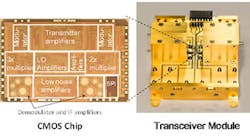Increasing the capacity of wireless networks has often called for laying more fiber optic cables between cellular stations to form backbone networks. But in recent years, it has become increasingly difficult to install enough fiber to match wireless demand—to say nothing of the high costs and trouble associated with laying it in crowded cities or places sheltered by mountains or rivers.
Now, researchers have built a transceiver chip with the capability to transmit data so quickly that it could potentially replace fiber optics with high-speed wireless channels. The researchers, from the Tokyo Institute of Technology and Fujitsu Laboratories, recently tested a chip that transmits at 56 Gbits/s. They have called it a new record for complementary metal-oxide semiconductor (CMOS) chips.
The chip’s introduction comes at a time when sharp increases in wireless traffic have spread concerns about a shortage of spectrum. However, the new device takes advantage of millimeter waves, a widely unused part of the spectrum that holds huge potential for new high-capacity networks. Mm-waves are expected to be one of the vertebrae in the backbone of fifth-generation, or 5G, wireless technology.
Operating between 72 and 100 GHz spectrum, the circuits inside the chip split data signals in two, with each converted to different mm-wave frequencies and then recombined. The circuit can modulate an ultra-wideband (UWB) signal of 20 GHz, with extremely low noise and similar losses at 10 GHz, resulting in high-quality signals.
The signal converted to mm-waves is transported over the circuit board’s signal path and supplied to the antenna, which is made out of a waveguide. The researchers built interface between the waveguide and the circuit board, using a special lattice of interconnects to adjust the impedance for the UWB signal range. Using this kind of modulation, the loss between the waveguide and the circuit board could be limited.
Extremely fast wireless speeds—far above 1 gigabit per second—are being investigated more closely now that research into 5G technology has begun. Wireless carriers have said that 5G wireless networks would serve as more of an “infrastructure” for new technologies, like virtual and augmented reality, along with the Internet of Things (IoT).
The researchers suggested that the new transceiver could make it possible to increase the capacity of wireless equipment. High-output amplifiers could be combined with the chip, increasing the transmission range beyond the 10 cm they achieved in the laboratory.
Put together with baseband circuits, the new transceiver could find its way into the wireless trunk lines of cellular base stations. The researchers are aiming for commercial products based on the chip to launch around 2020—the same timeframe that wireless companies expect to deploy 5G networks.

